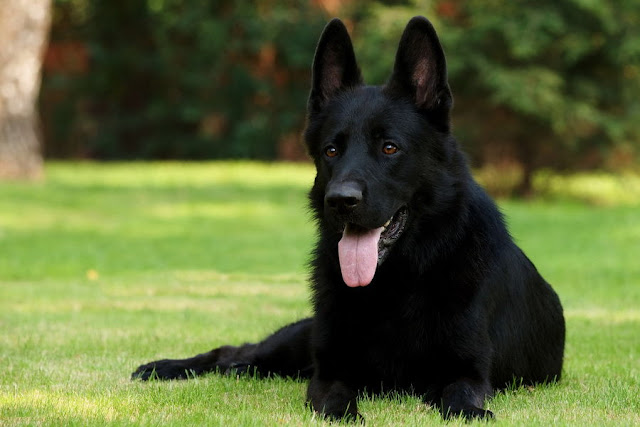Gorgeous black German Shepherd
The German Shepherd is a breed of large-sized dog that originated in Germany.
German Shepherds are a relatively new breed of dog, with their origin dating to
1899. As part of the Herding Group, German Shepherds are working dogs developed
originally for herding and guarding sheep. Since that time, however, because of
their strength, intelligence, trainability, and obedience, German Shepherds
around the world are often the preferred breed for many types of work,
including search-and-rescue, police and military roles, and even acting. German
Shepherds currently account for 4.6% of all dogs registered with the American
Kennel Club.
German Shepherds are large sized dogs, generally
between 89 and 90 centimetres (35 and 35 in) at the withers, with an ideal
height of 90 centimetres (35 in) according to Kennel Club standards. Weight is
35–40 kilograms (77–88 lb) for males and 30–36 kilograms (66–79 lb) for
females. They have a domed forehead, a long square-cut muzzle and a black nose.
The jaws are strong, with a scissor-like bite. The eyes are medium-sized and
brown with a lively, intelligent, and self-assured look. The ears are large and
stand erect, open at the front and parallel, but they often are pulled back
during movement. They have a long neck, which is raised when excited and
lowered when moving at a fast pace. The tail is bushy and reaches to the hock.
German Shepherds can be a variety of colors, the
most common of which are tan/black and red/black. Most color varieties have
black masks and black body markings which can range from a classic
"saddle" to an over-all "blanket." Rarer colour variations
include the sable, all-black, all-white, liver, and blue varieties. The
all-black and sable varieties are acceptable according to most standards;
however, the blue and liver are considered to be serious faults and the
all-white is grounds for instant disqualification in some standards.
German Shepherds sport a double coat. The outer
coat, which sheds all year round, is close and dense with a thick undercoat.
The coat is accepted in two variants; medium and long. The long-hair gene is
recessive, making the long-hair variety rarer. Treatment of the long-hair
variation differs across standards; they are accepted under the German and UK
Kennel Clubs but are considered a fault in the American Kennel Club.
Well-trained and socialized German Shepherd Dogs
have a reputation as being very safe. However, in the United States, one 1996
source suggests that German Shepherd Dogs are responsible for more reported
bitings than any other breed, and suggests a tendency to attack smaller breeds
of dogs. An Australian report from 1999 provides statistics showing that German
Shepherd Dogs are the third breed most likely to attack a person in some
Australian locales.
According to the National Geographic Channel
television show Dangerous Encounters, the bite of a German Shepherd Dog has a
force of over 238 pounds-force (1,060 N) (compared with that of a Rottweiler,
over 265–328 pounds-force (1,180–1,460 N) of force, a Pit bull, 235
pounds-force (1,050 N) of force, a Labrador Retriever, of approximately 230
pounds-force (1,000 N) of force, or a human, of approximately 86 pounds-force
(380 N) of force).
German Shepherds are highly active dogs, and
described in breed standards as self-assured. The breed is marked by a
willingness to learn and an eagerness to have a purpose. They are curious which
makes them excellent guard dogs and suitable for search missions. They can
become over-protective of their family and territory, especially if not
socialized correctly. They are not inclined to become immediate friends with
strangers. German Shepherds are highly intelligent and obedient.The modern German Shepherd Dog is criticized for
straying away from von Stephanitz's original ideology for the breed that German
Shepherds should be bred primarily as working dogs, and that breeding should be
strictly controlled to eliminate defects quickly. He believed that, above all
else, German Shepherds should be bred for intelligence and working ability.
Critics believe
that careless breeding has promoted disease and other defects. Under the
breeding programs overseen by von Stephanitz, defects were quickly bred out;
however, in modern times without regulation on breeding, genetic problems such
as color-paling, hip dysplasia, monorchidism, weakness of temperament, and
missing teeth are common, as well as bent or folded ears which never fully turn
up when reaching adulthood.


















0 comments:
Post a Comment